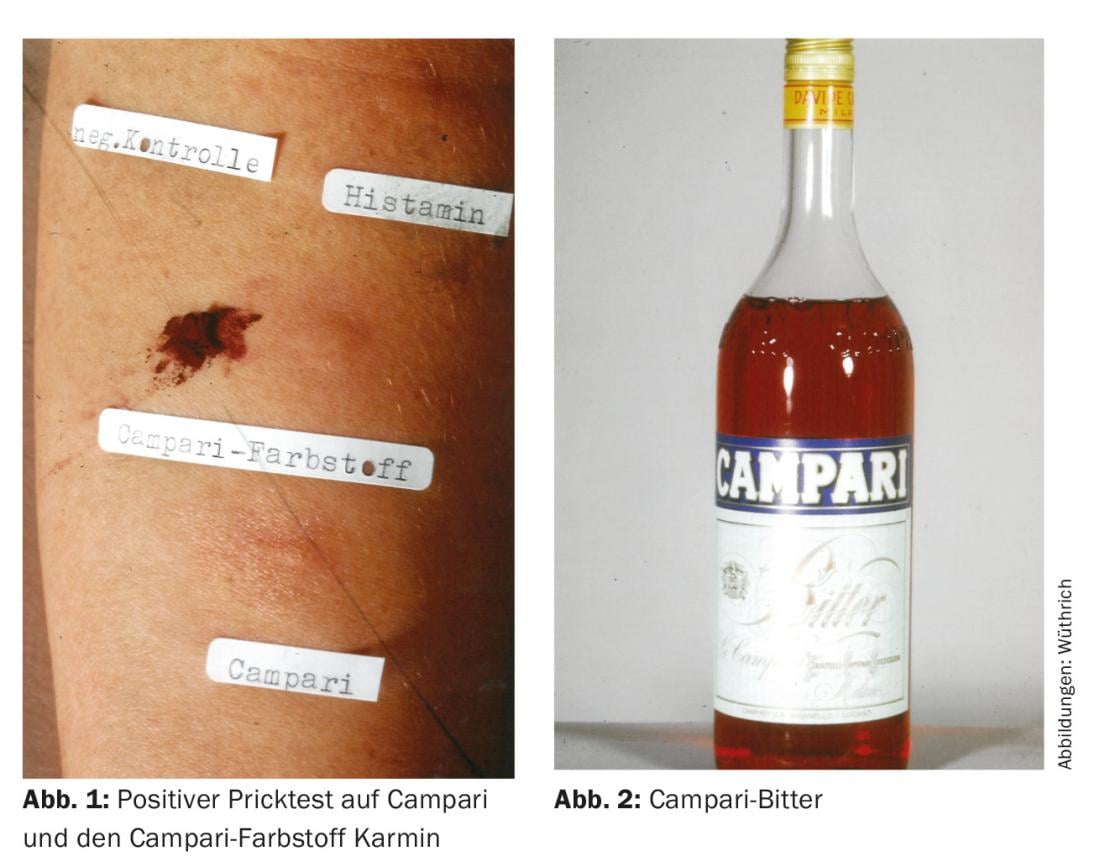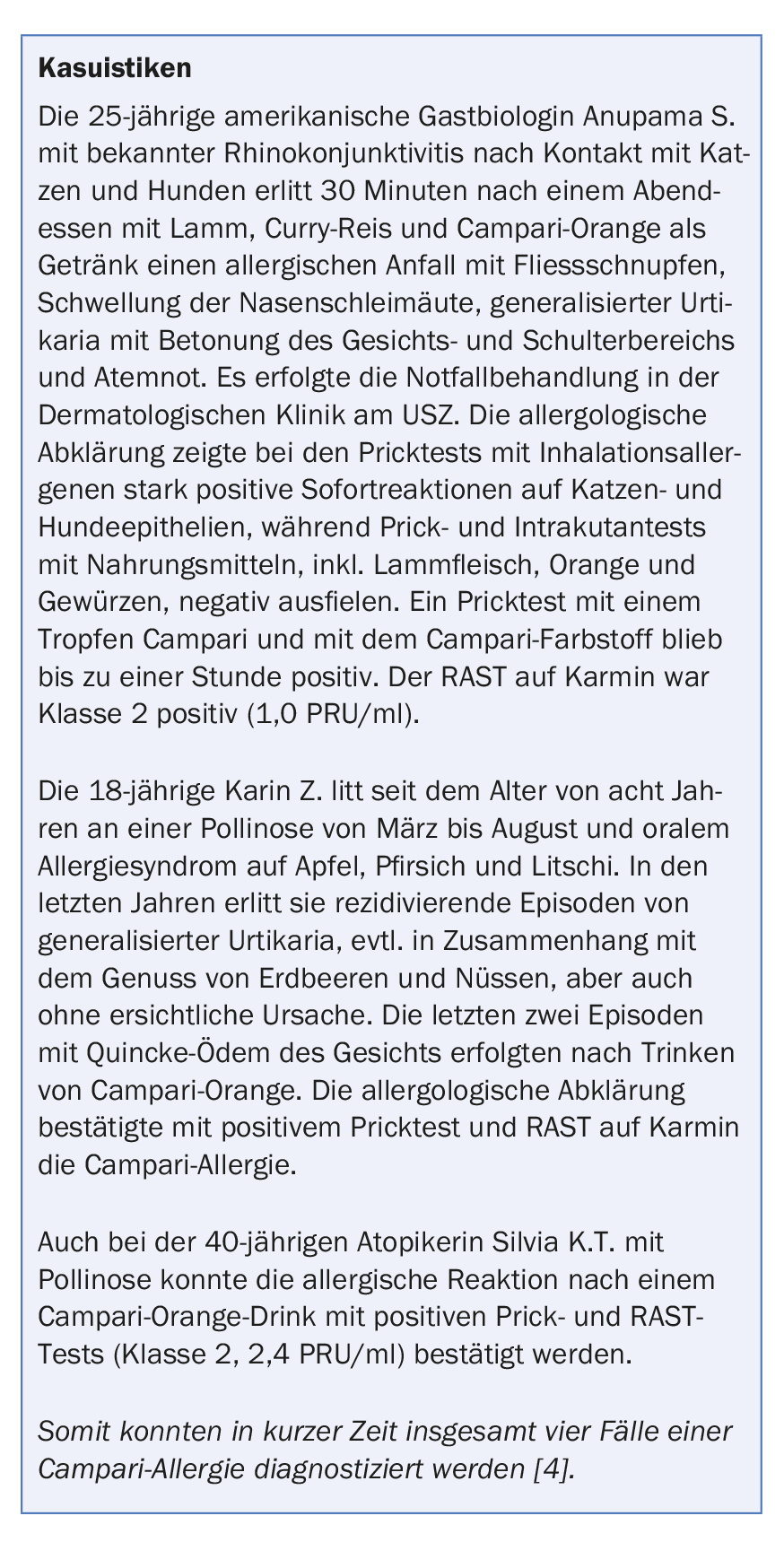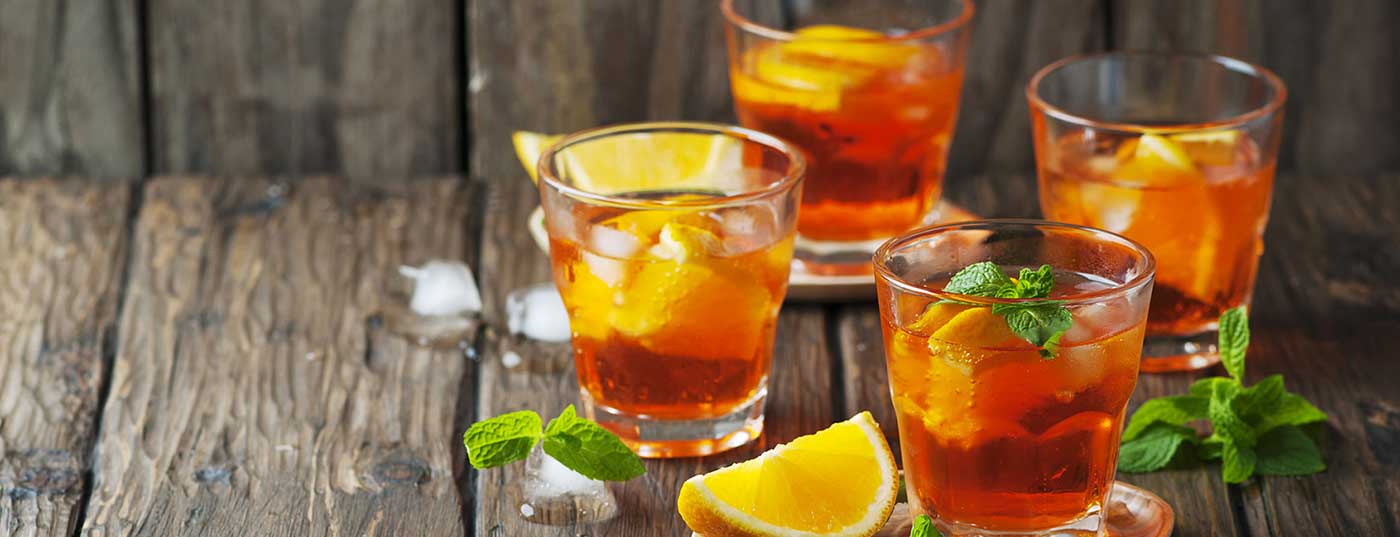Anamnesis: In Monika B., a 34-year-old atopic with known springtime pollinosis and mild intermittent bronchial asthma, a garden party she had organized ended abruptly in the emergency ward of the nearby hospital. Generalized urticaria, Quincke’s edema of the lips and eyelids, asthma attack, nausea, vomiting, diarrhea, and finally anaphylactic shock occurred 15 minutes after consumption of a Campari orange cocktail and salty cookies and a nut mixture.
Allergological clarification
Prick skin tests with inhalation allergens of the standard series at the allergy ward of the University Hospital Zurich showed positive immediate reactions to tree pollen, house dust mites and animal epithelia.
Prick tests with various nuts and seeds were negative, so the patient was instructed to bring the Campari bottle to the next consultation (in the meantime, the atopic patient had tolerated fresh and canned orange juice without reaction). In fact, the prick test with one drop of Campari showed a strong positive immediate reaction (++), in control subjects the test was negative. The 1-liter Campari bitters bottle purchased in the duty-free store did not have a declaration of ingredients, so the Campari manufacturer in Milan was asked in writing (in Italian) to tell us the composition of the aperitif. For three months I received no news, until shortly before Christmas, when a chemist from the company in Milan called: an allergic reaction to Campari had never happened before in the history of the long-standing company (the alcoholic red aperitif was introduced by Gaspare Campari in 1860). After a detailed description of the serious incident, it was agreed that small numbered samples of the main ingredients would be sent for testing after the New Year. After the number of the positive sample is given, I am immediately informed of the name of the reacting substance.

Of the many samples, only the red dye was positive (Fig. 1), but negative in control subjects. Meanwhile, at home, I had read on the label of my Campari bottle (Fig. 2) that it contains the dye E120 (true carmine, crimson, carminic acid, cochineal), which was confirmed to me from Milan. Also, the patient now reported moderate allergic symptoms after ingestion of colored desserts, which probably contained the undeclared dye E120. Also a prick test with the dye carmine 0.5% (Brial GmbH) was ++ positive. In a RAST specially prepared by Prof. Gunnar Johansson in Uppsala (Sweden), specific IgE to the carmine dye of Campari (class 2, 0.8 PRU/ml) could be detected in the patient’s serum.
Diagnosis
- Campari anaphylaxis in IgE sensitization to true carmine (E120);
- Rhinoconjunctivits pollinosa on early bloomers;
- intermittent, perennial bronchial asthma (house dust mite, animal epithelial).
Comment
The recipe of Campari bitters is said to contain over 80 ingredients and is kept secret. However, some ingredients are known. According to the Campari Group, only Luca Garavoglia, the company’s president, produces the base concentrate with the help of the technical director and eight employees. Luca Garavoglia is also said to be the only person who knows the complete original recipe. This includes quinine and bitter herbs, rhubarb, pomegranate, spices, ginseng, citrus oil and orange peel. One of the main ingredients is the bark of the Cascarilla tree. The food colorant carmine (E120) is used for the intense red color. True carmine (cochineal, E120) is mainly used as a natural colorant for alcoholic and non-alcoholic beverages (San Pellegrino Sanbitter, Aperol, etc.), food products, and medical and cosmetic products (lipstick, eye shadow). Carmine is extracted from dried powdered females of the tropical scale insect Dactylopius coccus. The cochineal scale insect (cochineal aphid or cochineal) is a species of insect originally found in Central and South America as a pathogen on opuntias (cacti). From the female animals carminic acid is obtained, which is the basis for the production of the dye carmine. The females of the cochineal scale insect are wingless, broad-ovate to round, and about 6-7 mm long (Fig. 3) .

They appear dark purple due to the high concentration of carminic acid stored in the fat body, which probably serves as a defense against predators and parasites. When crushed, they are bright red (Fig. 4).

The patient had become sensitized to the dye contained in the pink-tinted eyeliner she was using. After experiencing itching on the eyelids after using this eyelid pencil, she stopped using it. Testing with different pink eye sticks was also positive (Fig. 5 A and B).

As early as 1961, three cases of contact allergy (late type reaction) to the carmine red contained in lipstick were described [1]. However, the observation made in Zurich is the first description of an immediate-type allergy to carmine with detection of specific IgE antibodies [2]. Subsequently, we described another three cases (box) [3,4] and after our publication, the publication of another case appeared in France [5]. A later report involved severe asthma after occupational exposure to the food dye cochineal/carmine [6]. Additional cases were published along with reviews in 1999 and 2009 [7,8]. The last case report in 2015 involved a 52-year-old woman with repeated anaphylactic reactions associated with colored analcoholic beverages and fruit juices [9].

In 2006, the Campari Group company decided to switch to artificial colorants in Campari (but not in Aperol), so according to the label declaration, the colorants used today are tartrazine (E102), azo ruby (carmoisine) (E122) and brilliant blue FCF (E133).
Literature:
- Sarkany I, Meara Rh, Everall J: Cheilitis due to carmine in lip salve. Trans St Johns Hosp Dermatol Soc 1961; 46: 39-40.
- Kägi M, Wüthrich B, Johansson SGO: Campari-orange anaphylaxis due to carmine allergy. Lancet 1994; 344: 60-61.
- Kägi M, Wüthrich B: Anaphylaxis following ingestion of carmine. Ann Allergy Asthma Immunol 1996; 76: 296.
- Wüthrich B, Kägi M, Stücker W: Anaphylactic reactions to ingested carmine (E 120). Allergy 1997; 52: 1133-1137.
- Beaudouin E, et al: Food anaphylaxis following ingestion of carmine. Ann Allergy Asthma Immunol 1995; 74(5): 427-430.
- Stücker W, Roggembuck D, von Kirchbach G: Severe asthma after occupational exposure to the food dye cochineal/carmine. Allegro J 1996; 5: 143-146.
- DiCello MC, et al: Anaphylaxis after ingestion of carmine colored foods: two case reports and a review of the literature. Allergy Asthma Proc 1999; 20(6): 377-382.
- Greenhawt MJ, Baldwin JL: Carmine dye and cochineal extract: hidden allergens no more. Ann Allergy Asthma Immunol 2009; 103(1): 73-75.
- De Pasquale T, et al: Recurrent Anaphylaxis: A Case of IgE-Mediated Allergy to Carmine Red (E120). J Investig Allergol Clin Immunol 2015; 25(6): 440-441.
DERMATOLOGIE PRAXIS 2016; 26(4): 39-41
DERMATOLOGIE PRAXIS 2018 Special Edition (Anniversary Issue), Prof. Brunello Wüthrich











